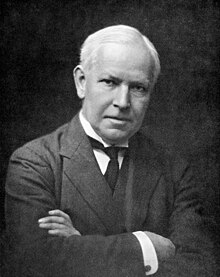G. Elliot Smith
| Grafton Elliot Smith | |
|---|---|

Grafton Elliot Smith
|
|
| Born |
15 August 1871 Grafton, New South Wales |
| Died | 1 January 1937 (aged 65) Broadstairs, Kent, England |
| Residence | United Kingdom |
| Nationality | Australia |
| Fields |
Anatomy Archaeology |
| Alma mater | University of Sydney, University of Cambridge |
| Notable awards |
Royal Medal (1912) Fellow of the Royal Society |
Sir Grafton Elliot Smith, FRSFRCP (15 August 1871 – 1 January 1937) was an Australian-British anatomist, Egyptologist and a proponent of the hyperdiffusionist view of prehistory. He believed in the idea that cultural innovations occur only once and that they spread geographically. Based on this, he traced the origins of many cultural and traditional practices across the world, including the New World, to ideas that he believed came from Egypt and in some instances from Asia. An expert on brain anatomy, he was the first to study Egyptian mummies using radiological techniques. He took an interest in extinct humanoids and was embroiled in controversy over the authenticity of the Piltdown Man.
Smith was born in Grafton, New South Wales to Stephen Sheldrick Smith who had moved to Australia from London in 1860 and Mary Jane, née Evans. He received his early education from Grafton Public School where his father was headmaster. When the family moved to Sydney in 1883 he went to Darlington Public School before joining Sydney Boys High School. He attended evening classes on physiology by Thomas Anderson Stuart and took an early interest in biology. In an autobiographical note Smith noted that Stuart had shown them the convolutions of the human brain and declared that nobody understood them fully. Smith decided at that point that he would work towards understanding them. Accordingly, he went to study medicine at the University of Sydney in 1888 and received a Doctor of Medicine in 1895, with a dissertation on the fore-brain of the monotremes) and developed an interest in the anatomy of the human brain. He received a James King travelling scholarship and went to St John's College, Cambridge, graduating BA in 1896. Afterwards he catalogued the human brain-collection of the British Museum.
Smith obtained an appointment at the Cairo School of Medicine in 1900 on the suggestion of his anthropologist friend Alexander Macalister. Smith became archaeological advisor to the archaeological survey of Nubia in the wake of plans to construct the Aswan Dam which threatened to drown numerous archaeological sites. Smith conducted investigations on the brains of Egyptian mummies. He was the first to non-destructively use x-rays to study mummies. Smith took a special interest in the pathologies indicated in ancient skeletal remains. He noted for instance that many Egyptian skulls had biparietal thinning which had been common in European aristocrats in the past. Smith hypothesized this was the result of wearing heavy wigs or headgear. From 1909 to 1919 he was Professor in anatomy in Manchester, 1919–1937 he held the chair of Anatomy at the University College London. He was elected President of the Anatomical Society of Great Britain and Ireland for 1924 to 1927. During World War I he took an interest in the neurology of shell shock, visiting military hospitals and serving on the British General Medical Council.
...
Wikipedia
